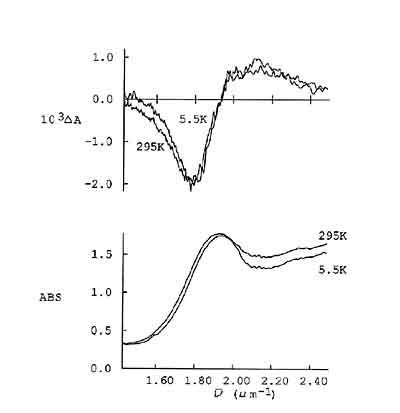Magnetic Circular Dichroism Spectra of Colloidal Gold Nanoparticles in Xerogels at 5.5 K
M. A. Zaitoun, W. Roy Mason, and C. T. Lin*
Department of Chemistry and Biochemistry,
Northern Illinois University,
DeKalb, Illinois 60115-2862 USA
This is an abstract
for a presentation given at the
Eighth
Foresight Conference on Molecular Nanotechnology.
There will be a link from here to the full article when it is
available on the web.
Colloidal gold nanoparticules of about 25 nm are encapsulated into an optically transparent sol-gel derived xerogel which maintains its optical quality (isotropic with no crystal strain or birefringence) for magnetic circular dichroism (MCD) measurements. The high quality xerogel (an inert matrix) allows us to examine the MCD and absorption spectra of surface plasmon band at 523 nm over a wide temperature range from 298 to 5.5 K. The band origin of the surface plasmon resonance is attributed to the collective oscillation of free conduction electrons induced by an interacting electromagnetic field. The total extinction cross section composed of absorption and scattering is given as a summation over all electric and magnetic multipole oscillations.
The analysis of a magnetic circular dichroism (MCD) spectrum provides the support for the characterization of excited electronic states. An observed MCD transition at 523 nm for the colloidal gold nanoparticles should indicate a non-zero value of the magnetic moment operator [m = - mB(L + 2S), where mB is the Bohr magneton, and L and S are the orbital and spin angular momentum of the collective electrons], electric moment operator, and a strong mixing of the excited states involved in the presence of the magnetic field.
The MCD and absorption spectra have been recorded and analyzed for the colloidal gold nanoparticles in H2O at 298 K, and in xerogel at 295 and 5.5 K. The later are shown in Figure 1. The results may be summarized as follows: (1) The surface plasmon peak is observed at 523, 531, and 529 nm for the colloidal gold nanoparticles in H2O at 298 K, in xerogel at 295 K and in xerogel st 5.5 K, respectively. The 8 nm red-shift in spectral peak is probably due to the difference in medium dielectric constant of sol-gel as compared to H2O; (2) The observed MCD signal is large, suggesting that both the magnetic and electric moments of surface plasmon resonances in colloidal gold are allowed; (3) The MCD spectra of the surface plasmon transition at 523 nm display an A-term-like feature and is shown to be temperature independent. The temperature independent nature of the dispersion represents the signature of an excited state phenomenon, (4) The MCD moments are analyzed to give A1/Do = 0.77 ± 0.05, 0.65 ± 0.02, and 0.70 ± 0.01 for the nanoparticles in H2O at 298 K, in xerogel at 295 K and in xerogel st 5.5 K, respectively. The A-term like dispersion probably does not originate from a single purely degenerate excited state, but represents a strong mixing of excited states. The contribution of spin and orbital motions to the observed MCD spectra will be discussed.

larger image |
| Figure 1 - The MCD (upper curves) and absorption (lower curves) spectra of colloidal gold nanoparticles in xerogel at 295 and 5.5 K. |
*Corresponding Address:
Chhiu-Tsu Lin, Professor of Chemistry
Department of Chemistry and Biochemistry
Northern Illinois University
DeKalb, Illinois 60115-2862
e-mail: [email protected]
|